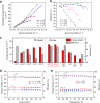Giant energy density and high efficiency achieved in bismuth ferrite-based film capacitors via domain engineering
- PMID: 29739938
- PMCID: PMC5940880
- DOI: 10.1038/s41467-018-04189-6
Giant energy density and high efficiency achieved in bismuth ferrite-based film capacitors via domain engineering
Abstract
Developing high-performance film dielectrics for capacitive energy storage has been a great challenge for modern electrical devices. Despite good results obtained in lead titanate-based dielectrics, lead-free alternatives are strongly desirable due to environmental concerns. Here we demonstrate that giant energy densities of ~70 J cm-3, together with high efficiency as well as excellent cycling and thermal stability, can be achieved in lead-free bismuth ferrite-strontium titanate solid-solution films through domain engineering. It is revealed that the incorporation of strontium titanate transforms the ferroelectric micro-domains of bismuth ferrite into highly-dynamic polar nano-regions, resulting in a ferroelectric to relaxor-ferroelectric transition with concurrently improved energy density and efficiency. Additionally, the introduction of strontium titanate greatly improves the electrical insulation and breakdown strength of the films by suppressing the formation of oxygen vacancies. This work opens up a feasible and propagable route, i.e., domain engineering, to systematically develop new lead-free dielectrics for energy storage.
Conflict of interest statement
The authors declare no competing interests.
Figures





Similar articles
-
Excellent Energy-Storage Properties Achieved in BaTiO3-Based Lead-Free Relaxor Ferroelectric Ceramics via Domain Engineering on the Nanoscale.ACS Appl Mater Interfaces. 2019 Oct 9;11(40):36824-36830. doi: 10.1021/acsami.9b10819. Epub 2019 Sep 6. ACS Appl Mater Interfaces. 2019. PMID: 31452366
-
Enhancement of Nonlinear Dielectric Properties in BiFeO3-BaTiO3 Ceramics by Nb-Doping.Materials (Basel). 2022 Apr 14;15(8):2872. doi: 10.3390/ma15082872. Materials (Basel). 2022. PMID: 35454569 Free PMC article.
-
Enhanced Energy Storage Performance in La-Doped CaBi4Ti4O15 Films Through the Formation of a Weakly Coupled Relaxor.Nanomaterials (Basel). 2024 Dec 13;14(24):1998. doi: 10.3390/nano14241998. Nanomaterials (Basel). 2024. PMID: 39728534 Free PMC article.
-
From Synthesis to Applications: Copper Calcium Titanate (CCTO) and its Magnetic and Photocatalytic Properties.ChemistryOpen. 2019 Jul 12;8(7):922-950. doi: 10.1002/open.201900133. eCollection 2019 Jul. ChemistryOpen. 2019. PMID: 31338276 Free PMC article. Review.
-
High-Energy-Density and High Efficiency Polymer Dielectrics for High Temperature Electrostatic Energy Storage: A Review.Small. 2022 Dec;18(50):e2205247. doi: 10.1002/smll.202205247. Epub 2022 Oct 20. Small. 2022. PMID: 36266932 Review.
Cited by
-
A Superparaelectric State in Relaxor Ferroelectric (Sr,Bi)TiO3-Bi(Mg,Ti)O3-Modified BaTiO3 Ceramics to Achieve High Energy Storage Performance.Materials (Basel). 2024 Jan 15;17(2):426. doi: 10.3390/ma17020426. Materials (Basel). 2024. PMID: 38255593 Free PMC article.
-
Superior Energy Density Achieved in Unfilled Tungsten Bronze Ferroelectrics via Multiscale Regulation Strategy.Adv Sci (Weinh). 2023 Jun;10(17):e2300227. doi: 10.1002/advs.202300227. Epub 2023 Apr 21. Adv Sci (Weinh). 2023. PMID: 37083234 Free PMC article.
-
Microstructural Origin of the High-Energy Storage Performance in Epitaxial Lead-Free Ba(Zr0.2Ti0.8)O3 Thick Films.Materials (Basel). 2022 Sep 30;15(19):6778. doi: 10.3390/ma15196778. Materials (Basel). 2022. PMID: 36234119 Free PMC article.
-
Constructing phase boundary in AgNbO3 antiferroelectrics: pathway simultaneously achieving high energy density and efficiency.Nat Commun. 2020 Sep 24;11(1):4824. doi: 10.1038/s41467-020-18665-5. Nat Commun. 2020. PMID: 32973146 Free PMC article.
-
Relaxor-Ferroelectric Films for Dielectric Tunable Applications: Effect of Film Thickness and Applied Electric Field.Materials (Basel). 2021 Oct 27;14(21):6448. doi: 10.3390/ma14216448. Materials (Basel). 2021. PMID: 34771973 Free PMC article.
References
-
- Cao Y, Irwin PC, Younsi K. The future of nanodielectrics in the electrical power industry. IEEE Trans. Dielectr. Electr. Insul. 2004;11:797–807. doi: 10.1109/TDEI.2004.1349785. - DOI
-
- Shen Y, Zhang X, Li M, Lin Y, Nan C. Polymer nanocomposite dielectrics for electrical energy storage. Natl. Sci. Rev. 2017;4:23–25. doi: 10.1093/nsr/nww066. - DOI
-
- Chen Q, Shen Y, Zhang S, Zhang QM. Polymer-based dielectrics with high energy storage density. Annu. Rev. Mater. Res. 2015;45:433–458. doi: 10.1146/annurev-matsci-070214-021017. - DOI
Publication types
LinkOut - more resources
Full Text Sources
Other Literature Sources
Molecular Biology Databases

